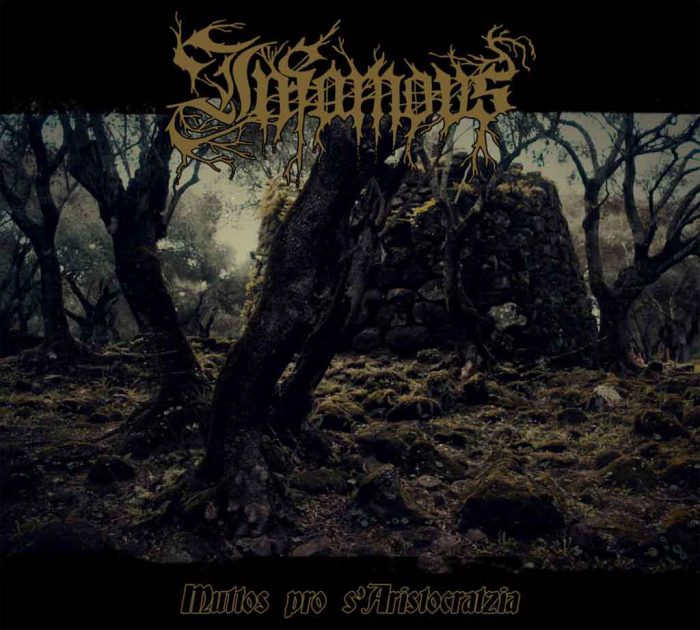The faster news cycle of the post-internet metal era places pressure on bands to release frequently in order to cultivate an audience which can pick them out of the seemingly endless flow of new and similar material. Having taken a pause, Infamous returns with more of an influence from traditional black metal in its aesthetic.
Expanding its focus gives Infamous more room to move and more importantly, less need for constant intensity, allowing songs to breathe and develop natural inner conflicts. This allows the use of contrast as a weapon, and presents the trademark Infamous melodic fractal arabesques as the center and not outside of each song.
As a result, this feels like a unique take on Southern European black metal crossed with the Swedish melodic death metal approach which gradually mutates under layers of opposites formed of variations on its main themes, bringing its simplicity out in atmospheric repetition that shifts like layers of colored leaves in the wind during fall.
In turn this gives songs a stronger thematic identity, allowing them to stand apart from each other while retaining the recognizable “Infamous sound” of sentimental and ritual rhythms arising from oi/hardcore beats under alternately soaring and reposing self-referential melodies. This gives greater weight to the emotion that emerges from the story being told, since listeners have seen it birthed out of conflict, doubt, and ambiguity.
Melodies follow the idiosyncrasy of this band which is to create a gentle melodic fall through the scale that is then balanced by an anchoring three-chord progression, in seeming reverse from how most bands write riffs. Variations within that melodic fall and rhythms of the anchoring progression contribute the most to thematic development, which culminates often in the reversal of that progression, instilling a sense of rising above the finite.
While the essential elements of the sound used by this Sardinian band have not been displaced, to them comes a new palette of fundamental black metal patterns, sounding like presentation at arms or a walk through the ancient forest at night. These break up the savagery and give it context.
As always, keyboards counterpoint landmarking patterns like arpeggios, and foreshadow future thematic tributaries. Vocals seem to enjoy being detached from the driving rhythm of each passage, as if they were screaming for a different pace and path entirely, forming more of a background texture than lead instrument.
If you can imagine a fusion of early Darkthrone, first album Rotting Christ, and the architectural patterns of Hypocrisy and its black metal offshoot The Abyss, into which Ildjarn and Absurd style hardcore rhythms drop like overnight marches through valleys between mountain peaks, you have a vision of the new era of Infamous.
The best growth consists of evolution, or taking what is and refining it while slowly integrating the new ideas that work with everything already there, rather than “progress” or replacing the old ways with something untested, and here we see a gradual weaving of the old and new so that nothing is lost but intensity grows organically.
The title track combines Darkthrone-like percussion with a riff patterning sense that would have been at home on either of the first two Immortal albums, and uses it to delicately peel back the gap between a melodic figure and its resolution into which drops a variation on riffs from the first album, uniting past and future.
With Muttos Pro S’Aristocratzia, Infamous both refines its past sound and presents ideas in enough isolation to be distinctive, giving both old and new patterns a chance to become part of the language of this act that despite hybrid influences carries the banner of traditional black metal by partially reinventing it.
Tags: Black Metal, infamous, sardinia



He is planning to release it on CD in autumn despite the bandcamp page saying there are no plans for it yet. Just want to assure anyone else who still likes buying physical copies – it is coming!
The new Desecresy is also out: https://xtreemmusic.bandcamp.com/album/towards-nebulae
Hey Brett,
You wrote: “this feels like a unique take on Southern European black metal…”
Can you elaborate on key features of Southern European black metal?
All that comes to mind is Hellenic and Italian, into the latter of which I can only place… Mortuary Drape ‘n shit? Well, and Infamous, obvz.
Swiss, i.e. Hellhammer/Celtic Frost?
Certainly you’re not including France.
“If you can imagine a fusion of early Darkthrone, first album Rotting Christ, and the architectural patterns of Hypocrisy and its black metal offshoot The Abyss, into which Ildjarn and Absurd style hardcore rhythms drop …”
Shit, B. I can’t hardly imagine that haha, never heard of Hypocrisy (am I missing out big-time?), but I appreciate your specificity, way better than reviews that say, ‘It’s lo-fi and blasting, but then like slow but like Iron Maiden, and then noisy, etc. It’s really loud always, kicks ass.”
The first two Hypocrisy albums and associated EPs are good stuff although low-tech; the first The Abyss is essential black metal listening. When I said Southern European black metal, I was thinking mostly of the Greeks (Varathron, Rotting Christ) and some of the black metal inspired death metal like Maleficarum (which is closest, really, to first album Darkthrone). Thanks for the kind words on the review.